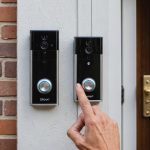Your Ultimate Guide to Seamless Smart Home Automation: Monitor Your Home in Real Time from Your Smartphone
In the era of smart technology, transforming your home into a fully automated and integrated smart home is more accessible than ever. This guide will walk you through the essentials of smart home automation, helping you understand how to monitor and control your home from the comfort of your smartphone.
Understanding Smart Home Automation
Smart home automation is about creating a living space where various devices and systems work together seamlessly to enhance your comfort, security, and energy efficiency. This technology leverages advanced devices and platforms to automate tasks, making your life easier and more convenient.
Additional reading : Comprehensive Smartphone Setup for Your Smart Video Doorbell: The Essential Installation Handbook
Key Components of Smart Home Automation
-
Voice Control: Devices activated by voice, such as those powered by Amazon Alexa, Google Assistant, or Apple Siri, allow you to manage various home functions like lighting, temperature, and multimedia playback with simple voice commands. This is particularly useful for contactless operations and accessibility, enhancing the overall smart home experience[1].
-
Smart Lighting: Intelligent lighting automation is one of the most popular smart home suggestions. Imagine a soft night light that gently illuminates your path to the bathroom or kitchen, ensuring safety without blinding you. Smart lighting can be programmed to follow your daily routine, intensifying in the morning to wake you up gently or dimming in the evening for a relaxing atmosphere[1].
In the same genre : Seamless Living: Innovative Strategies for Merging Voice Assistants with Smartphone-Managed Smart Homes
-
Automated Security Systems: Automated security systems integrate surveillance cameras, smart locks, and alarm systems that you can monitor and control remotely. These systems offer unique features like high-definition video, night vision, and motion detection. Some models allow real-time streaming to your smartphone, enabling you to keep an eye on your home from anywhere[1].
Choosing the Right Automation Platform
Selecting the right platform is crucial for integrating all your smart devices into a cohesive system.
Home Assistant
Home Assistant is a highly recommended open-source tool for smart home automation. It is compatible with a wide range of devices from over 1,000 manufacturers and can run on various hardware platforms including Raspberry Pi, Mac, Android, and Windows. Home Assistant stores your data locally, ensuring privacy and security. It also supports extensions like DNS blocker, NodeRed, and Spotify Connect, enhancing your automation experience[3].
Tuya Smart
Tuya Smart is another popular platform that supports a broad range of devices, from smart lighting and security systems to environmental control devices like thermostats and humidity sensors. This platform allows you to automate every aspect of your home, including programming lighting, configuring alarm systems, and controlling environmental settings[4].
Calaos
Calaos is a free and open-source tool that provides total control over your smart home. It helps you create the best experience by ensuring lights are dimmed, blinds are closed, and relaxing music is ready to greet you after a long day. Calaos also allows you to control music from anywhere in your home and create various scenarios with a single click[3].
Setting Up Your Smart Home
Setting up your smart home involves several key steps to ensure a seamless and integrated experience.
Selecting the Right Hardware
When starting with Home Assistant, you have several hardware options to choose from, including Raspberry Pi, Khadas VIM, old PCs, Mini PCs, Docker, or virtual machines. Each option has its pros and cons, and the choice should be based on your technical knowledge and preferences. For instance, the Raspberry Pi is an economical and accessible solution that requires minimal technical expertise, while virtual machines like Proxmox offer more advanced features but require more maintenance[2].
Central Hub or Platform
Choosing a central hub or platform is essential for integrating all your smart devices. This could be a physical device like the eufy HomeBase S380 or Amazon Echo, or a software platform like Apple HomeKit. The hub acts as the brain of your smart home, enabling different devices to communicate with each other[1].
Unified Interface
Using applications that can control multiple devices from different brands and types is crucial. Applications like IFTTT (If This Then That) allow you to create customized automations and interactions between various smart devices, enhancing their functionality and your convenience[1].
Robust Network Connection
A robust and reliable WiFi network is critical for smart home devices, especially if they are spread across your home. Consider upgrading your router or adding WiFi repeaters or mesh networks to ensure a solid connection in all areas of your home[1].
Automating Your Home
Automation is the heart of smart home technology, allowing your home to adapt to your needs, habits, and expectations.
Scenarios and Automations
Effective automation involves creating scenarios that make your home respond to your daily routines. For example, your lights can turn on and off automatically, your appliances can switch off when they go into standby mode, and your blinds can open and close based on the time of day or your presence. This level of automation ensures that your smart home anticipates and meets your needs throughout the day[2].
Using Triggers and Conditions
To make your automations more efficient, use triggers and conditions. For instance, you can set up triggers based on time, presence, or specific events. Home Assistant allows you to manipulate automations under the “Automation” settings, testing various possibilities to exploit them further. Using ID triggers can make your automations even more performant once you understand the logic behind them[2].
Security and Surveillance
Security is a paramount aspect of smart home automation, and there are several ways to enhance it.
Smart Security Systems
Automated security systems include surveillance cameras, smart locks, and alarm systems. Smart cameras offer high-definition video, night vision, and motion detection. Some models allow real-time streaming to your smartphone, enabling you to monitor your home from anywhere. Features like facial recognition can distinguish between known residents and strangers, adding an extra layer of security[1].
Access Control
Smart locks and access control systems can be integrated into your automation platform, allowing you to grant or deny access remotely. These systems can also be programmed to lock doors automatically when you leave the house or unlock them as you approach[4].
Energy Efficiency and Environmental Control
Smart home automation also focuses on energy efficiency and environmental control.
Smart Thermostats
Smart thermostats can be programmed to adjust the temperature based on your schedule and preferences. They can learn your habits and optimize energy consumption, ensuring your home is always at the right temperature without wasting energy. For example, smart thermostats can lower the temperature when you are away or asleep, and raise it when you wake up or return home[3].
Smart Lighting and Appliances
Smart lighting and appliances can be controlled and programmed to optimize energy usage. Smart lighting can be adjusted in terms of brightness, color, and warmth to match your mood or activity. Smart appliances like refrigerators, ovens, and washing machines can be controlled remotely, optimizing resource usage and adapting to user preferences[1].
Practical Insights and Actionable Advice
Here are some practical tips to help you get the most out of your smart home automation:
Plan for Scalability
When setting up your smart home, think about future expansions. Choose a system that is scalable, allowing you to add more devices or upgrade existing ones without needing a complete overhaul[1].
Use Unified Interfaces
Employ applications that can control multiple devices from different brands and types. This simplifies the control process and enhances the functionality of your smart devices[1].
Ensure Robust Network Connectivity
A reliable WiFi network is essential for smart home devices. Invest in a good router and consider adding WiFi repeaters or mesh networks to ensure a solid connection throughout your home[1].
Comparative Table of Smart Home Platforms
Here is a comparative table of some popular smart home platforms to help you make an informed decision:
| Platform | Compatibility | Key Features | Hardware Requirements | Data Storage |
|---|---|---|---|---|
| Home Assistant | Over 1,000 manufacturers | Local data storage, extensions like DNS blocker, NodeRed | Raspberry Pi, Mac, Android, Windows | Local |
| Tuya Smart | Broad range of devices including lighting, security, and environmental control | Programming lighting, configuring alarm systems, environmental control | Various devices from different brands | Cloud and Local |
| Calaos | Comprehensive control over lighting, music, and scenarios | Dimming lights, closing blinds, creating scenarios | Compatible with various hardware | Local |
| ioBroker | Over 500 integrations possible | Compatible with thermostats, lighting, blinds; visually appealing interfaces | Windows, Mac, OSX, Raspberry Pi, ARM | Local |
| Smarthomatic | Simple yet feature-rich interface | Secure communications, plant watering reminders, cooking plate control | Compatible with various hardware | Local |
Quotes and Real-Life Examples
-
“A well-configured smart home is one that anticipates and meets your needs throughout the day,” says a Home Assistant user. “When your lights turn on and off automatically, and your appliances switch off when they go into standby mode, that’s when you know your smart home is working for you.”[2]
-
“I was amazed by how easy it was to set up my smart home with Home Assistant,” shares another user. “The ability to control everything from a single interface has made my life so much easier. I can monitor my home in real time from my smartphone, which gives me a sense of security and peace of mind.”[3]
Transforming your home into a smart, automated living space is a journey that requires careful planning, the right technology, and a bit of creativity. By choosing the right platform, setting up a robust network, and automating various aspects of your home, you can create a seamless and integrated smart home experience. Whether it’s voice control, smart lighting, or advanced security systems, the possibilities are endless, and the benefits are undeniable.
In the words of a smart home enthusiast, “The future of living is here, and it’s smarter than ever. With the right tools and a little bit of know-how, you can turn your home into a haven of convenience, security, and energy efficiency.” So, take the first step today and discover how smart home automation can revolutionize the way you live.




